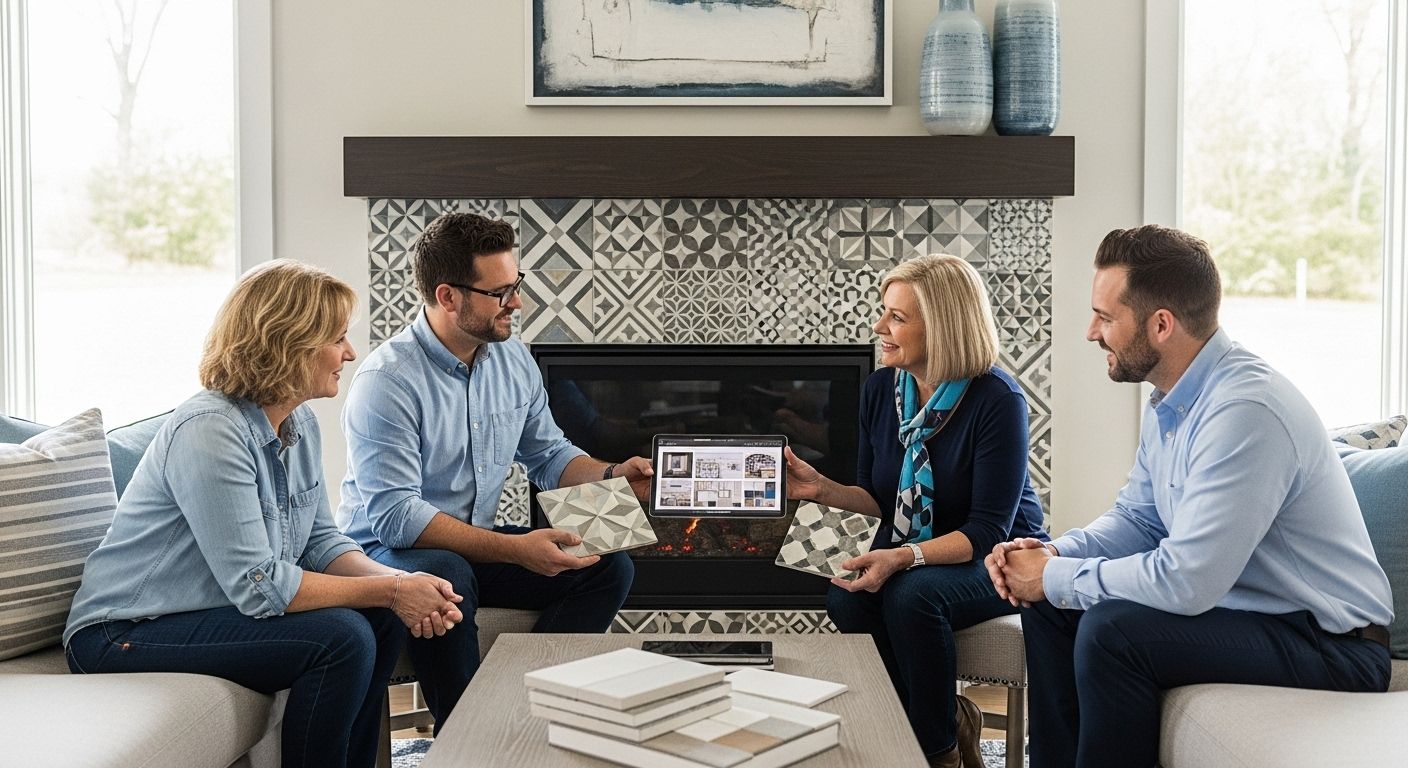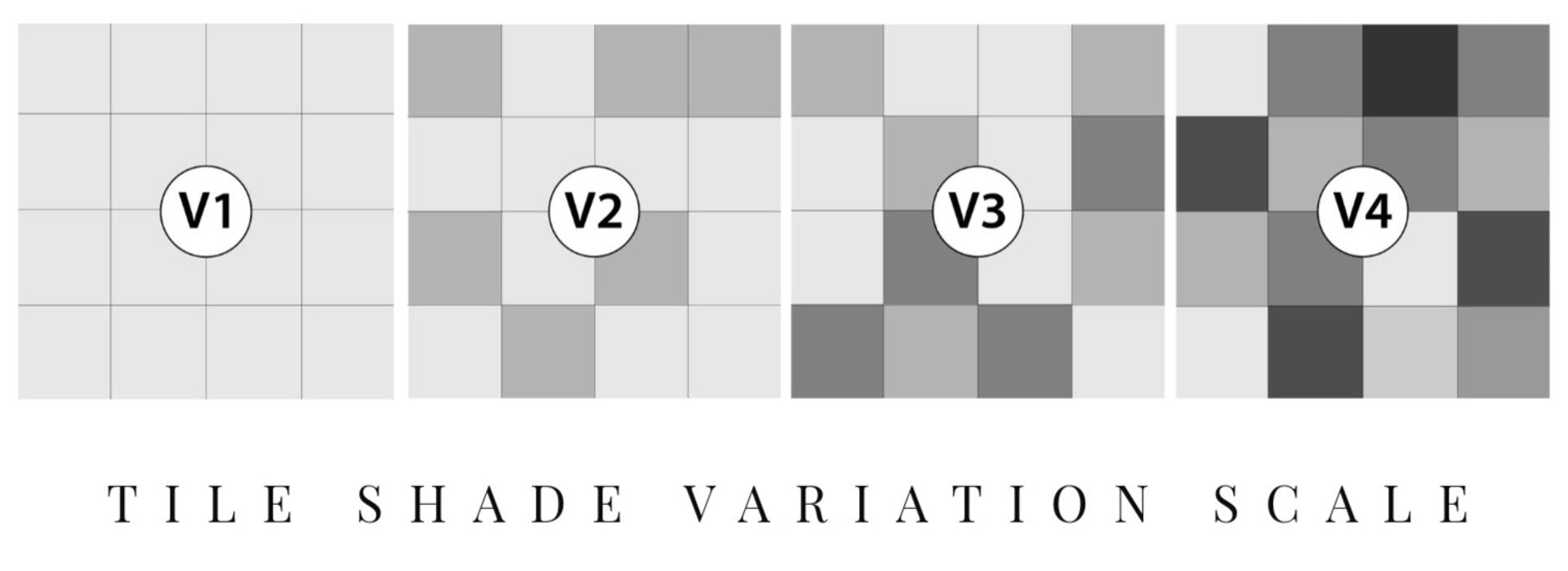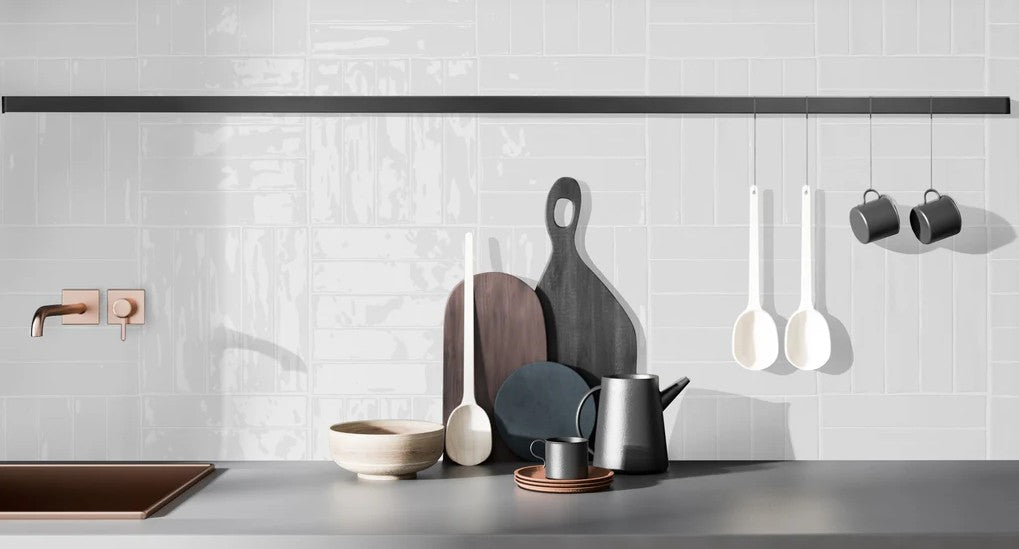Fireplace tile design shapes the entire mood of your living space. The size, color, and pattern you choose can make or break your room’s vibe. Here’s the shocker. Large format tiles in spacious rooms instantly create a sleek, modern focal point, while tiny mosaics bring detailed charm to smaller nooks. Most people think any pretty tile will do, but the real magic happens when you match tile scale and materials to your space and style. The difference is dramatic and a few tweaks can completely transform your home.
Table of Contents
- Consider The Size And Scale Of Your Fireplace
- Choose The Right Tile Material For Durability
- Explore Color Palettes That Complement Your Room
- Experiment With Patterns For Visual Interest
- Incorporate Textures To Add Depth
- Mix And Match Tiles For Unique Designs
- Create A Focal Point With A Bold Tile Choice
- Think About Maintenance And Cleaning Solutions
- Integrate Lighting To Highlight Your Tile Design
Quick Summary
| Takeaway | Explanation |
|---|---|
| Consider size and scale of tiles | Assess your fireplace’s dimensions to ensure appropriate tile sizes that enhance visual balance and aesthetics. |
| Choose durable tile materials | Select materials like porcelain or ceramic that resist heat and require minimal maintenance to prolong your fireplace’s life. |
| Incorporate a cohesive color palette | Match tile colors with existing room decor for a harmonious design that reflects your style and creates a desired ambiance. |
| Experiment with patterns for uniqueness | Use various tile patterns to add depth and character to your fireplace, turning it into a captivating focal point. |
| Integrate lighting to enhance design | Use strategic lighting techniques to highlight tile textures and colors, transforming your fireplace into a dynamic visual feature. |
1: Consider the Size and Scale of Your Fireplace
Designing a fireplace tile layout requires careful consideration of size and scale, which fundamentally impacts the aesthetic and functional harmony of your living space. The dimensions and proportions of your fireplace tile design will dramatically influence the room’s visual balance and overall architectural character.
Before selecting tiles, assess your fireplace’s physical dimensions and the surrounding architectural context. Key considerations include:
- Room size and ceiling height
- Existing architectural style
- Furniture placement and room layout
- Intended visual impact
According to the National Park Service preservation guidelines, the scale of fireplace elements should complement the room’s original proportions. An oversized tile design can overwhelm a small space, while undersized tiling might appear insignificant in larger rooms.
Measuring your fireplace’s width, height, and depth becomes crucial in determining appropriate tile sizes and patterns. Larger format tiles work beautifully in spacious rooms with high ceilings, creating a seamless, contemporary look. Conversely, smaller mosaic tiles can add intricate detail and visual interest in compact spaces.
Consider the visual weight of your tile selection. Darker, more substantial tiles can make a fireplace feel more prominent, while lighter, reflective tiles can create an illusion of expanded space. The tile’s texture, color, and size will interact with light and surrounding elements, ultimately defining the room’s atmosphere.
Remember that tile scale is not just about physical dimensions but about creating a balanced visual composition that enhances your living environment’s aesthetic and functional qualities.
2: Choose the Right Tile Material for Durability
Selecting the appropriate tile material is crucial for creating a long lasting and visually appealing fireplace design. Different tile materials offer unique characteristics that impact their performance, durability, and aesthetic potential in high heat and stress environments.
The primary tile materials suitable for fireplace applications include:
- Ceramic tiles
- Porcelain tiles
- Natural stone tiles
- Glass tiles
- Metal tiles
According to the National Performance Based Design Guide, ceramic tiles meeting ANSI A137.1 standards provide exceptional durability and resistance to thermal stress. Porcelain tiles, specifically, stand out as an excellent choice for fireplace surrounds due to their dense composition and superior strength.
Consider factors like heat resistance, thermal shock tolerance, and maintenance requirements when evaluating tile materials. Ceramic and porcelain tiles offer remarkable performance under high temperatures, while natural stone requires more careful selection and potential sealing to maintain its integrity.
Natural stone tiles like marble, granite, and slate bring unique textures and organic beauty but demand more maintenance. They can crack or discolor if not properly treated and sealed. Glass tiles provide a modern, reflective aesthetic but must be carefully selected to ensure heat resistance.
For homeowners seeking professional tile recommendations, consulting with experts can help navigate the complex landscape of material selection. Each tile type presents distinct advantages and potential limitations for fireplace design.
Ultimately, the right tile material balances aesthetic preference, functional performance, and long term durability, transforming your fireplace into a stunning focal point that withstands the test of time.
3: Explore Color Palettes That Complement Your Room
Selecting the right color palette for your fireplace tiles transforms the entire room’s atmosphere, creating a cohesive and visually harmonious design. Color selection goes beyond mere aesthetic preference and requires strategic consideration of your existing interior design elements.
Key color considerations include:
- Room’s existing color scheme
- Natural lighting conditions
- Overall architectural style
- Furniture and decor colors
- Emotional ambiance you want to create
According to archeworks.org, incorporating natural, calming hues like warm browns, muted greens, and creamy neutrals can create a peaceful sanctuary that promotes relaxation and comfort.
Neutral color palettes offer remarkable versatility, allowing seamless integration with various design styles. Soft grays, warm whites, and subtle beiges provide a timeless backdrop that can adapt to changing decor trends. For contemporary spaces, consider monochromatic schemes with varying tile textures to add depth and visual interest.
Bold color choices can make a dramatic statement. Blue and white tiles, for instance, can evoke a serene coastal ambiance, while black and white geometric patterns introduce a modern, sophisticated touch. These high-contrast designs draw attention and serve as a focal point in your living space.
Consider the psychological impact of colors. Warm tones like terracotta and deep reds create a cozy, inviting atmosphere, while cool blues and greens promote calmness and tranquility. The tile color should not only complement your room but also reflect your personal style and emotional preferences.
Remember that lighting dramatically influences color perception. Natural daylight and artificial lighting can transform tile colors throughout the day, so always view tile samples in your specific room environment before making a final decision.
4: Experiment with Patterns for Visual Interest
Pattern selection transforms a simple fireplace tile design into a captivating visual centerpiece, introducing depth, movement, and personality to your living space. Strategic tile pattern choices can dramatically alter the room’s aesthetic and emotional ambiance.
Popular fireplace tile pattern options include:
- Herringbone
- Chevron
- Geometric hexagon
- Subway tile layout
- Mosaic arrangements
- Diagonal grid
According to Ceramic Arts Network, understanding pattern dynamics requires thoughtful consideration of scale, visual rhythm, and spatial interaction. Complex patterns can create visual drama, while simpler layouts maintain a clean, understated elegance.
Geometric patterns like hexagons and diamond shapes introduce modern sophistication, breaking traditional rectangular tile constraints. These intricate designs draw the eye and create dynamic visual interest. Herringbone and chevron patterns offer classic elegance with a contemporary twist, providing subtle movement and texture.
Consider how pattern scale interacts with your fireplace and room dimensions. Large format tiles with minimal grout lines create a sleek, expansive look, whereas smaller mosaic tiles generate intricate visual texture. The pattern’s orientation can also manipulate perceived space proportions.
Monochromatic patterns using varied tile textures can add subtle sophistication without overwhelming the design. Mixing matte and glossy tiles in similar color families creates depth and intrigue while maintaining a cohesive aesthetic.
Remember that patterns should complement, not compete with your room’s existing design elements. The goal is to create a harmonious visual narrative that enhances your fireplace as a stunning architectural focal point.
5: Incorporate Textures to Add Depth
Texture transforms fireplace tile design from flat surfaces into dynamic, engaging visual experiences, creating layers of sensory intrigue that elevate your living space. Strategic texture selection can dramatically enhance the perception of depth and visual complexity.
Key texture categories for fireplace tiles include:
- Raised relief patterns
- Three dimensional sculptural tiles
- Rough stone finishes
- Smooth glazed surfaces
- Embossed ceramic designs
- Hand crafted irregular textures
According to scientific research on material environments, incorporating textured materials contributes significantly to psychological comfort and aesthetic appreciation. Textural variations create visual interest through light and shadow interactions, transforming an ordinary fireplace into a compelling architectural element.
Smooth, glossy tiles reflect light and create a sleek modern appearance, while rough stone textures evoke natural, rustic charm. Three dimensional tiles with intricate relief patterns introduce dramatic shadows and visual complexity, making the fireplace a true focal point.
Consider how different textures interact with your room’s existing design. Combining multiple texture types can create nuanced visual depth without overwhelming the space. For instance, pairing smooth ceramic tiles with rough stone accents generates a sophisticated, layered aesthetic.
Understand that texture is not just visual but also tactile. Running your hand across varied tile surfaces creates a multisensory experience that enriches your living environment. Select textures that not only look appealing but also provide an engaging physical interaction.
Remember that texture tells a story, communicating design intention and personal style through subtle material variations.
6: Mix and Match Tiles for Unique Designs
Mixing and matching tiles transforms a standard fireplace into a personalized artistic statement, allowing homeowners to break free from traditional design constraints and create truly distinctive spaces. The art of tile combination requires careful consideration of color, texture, shape, and visual harmony.
Effective tile mixing strategies include:
- Combining different tile sizes
- Blending complementary color families
- Integrating varied textures
- Creating geometric pattern interactions
- Balancing bold and neutral elements
Successful tile mixing demands a strategic approach. Establish a consistent visual thread that connects different tile elements, whether through color palette, geometric shape, or material finish. For instance, explore unique tile combinations that maintain a cohesive underlying design language.
Consider using a dominant tile as your primary surface coverage, then introducing accent tiles to create focal points. Geometric tiles like hexagons can provide interesting border details, while subway tiles offer clean, classic backgrounds. The key is achieving balance without overwhelming the visual landscape.
Color coordination plays a crucial role in tile mixing. Monochromatic schemes with varying shades and textures create sophisticated depth, while complementary color pairings introduce dynamic visual energy. Metallic accents or subtle shimmer tiles can break monotony and add sophisticated sparkle.
Remember that proportion and placement matter as much as tile selection. Strategic positioning of mixed tiles can guide the eye, create visual movement, and transform your fireplace into an architectural conversation piece. Experiment with asymmetrical designs or create gradual color transitions for added intrigue.
7: Create a Focal Point with a Bold Tile Choice
Bold tile choices transform an ordinary fireplace into an extraordinary architectural statement, commanding attention and infusing your living space with personality and visual drama. Selecting a striking tile design requires confidence and strategic design thinking.
Elements that create bold fireplace tile impact include:
- High contrast color palettes
- Unexpected geometric patterns
- Metallic finish tiles
- Large scale graphic designs
- Intricate mosaic arrangements
- Three dimensional sculptural tiles
According to architectural design resources, classic black and white checkered tiles can instantly elevate interior aesthetics with their iconic design. Geometric patterns create visual tension and energy, drawing the eye and anchoring the room’s entire aesthetic composition.
Metallic and reflective tiles offer another avenue for dramatic expression. Dark, faceted tiles with subtle shimmer can radiate elegance, creating an atmospheric centerpiece that transforms surrounding light and space. Consider tiles with depth, texture, and unexpected visual complexity.
When implementing bold design, balance remains crucial. A single dramatic wall or carefully curated tile section prevents overwhelming the space. Explore unique tile options that complement your existing interior while making a confident design statement.
Remember that a bold tile choice is more than aesthetic decoration. It represents a personal design narrative, reflecting your creativity and willingness to challenge conventional design boundaries.
8: Think About Maintenance and Cleaning Solutions
Selecting fireplace tiles requires strategic consideration of long term maintenance and cleaning requirements, ensuring your beautiful design remains pristine and functional through years of use. The right tile choice can significantly simplify your cleaning routine and preserve aesthetic appeal.
Key maintenance considerations include:
- Surface porosity
- Grout line complexity
- Tile material durability
- Heat and soot resistance
- Chemical cleaning compatibility
- Potential stain absorption
According to the Centers for Disease Control and Prevention, regular tile surface cleaning prevents the buildup of harmful allergens and irritants. Ceramic and porcelain tiles offer superior maintenance advantages, featuring smooth surfaces that resist staining and require minimal upkeep.
Consider tile texture and surface complexity when evaluating cleaning difficulty. Smooth, glazed tiles with minimal grout lines simplify maintenance, allowing quick wipe downs and preventing debris accumulation. Rough, textured tiles, while visually appealing, demand more intensive cleaning strategies.
Choose grout materials carefully. Epoxy grouts provide superior stain resistance compared to traditional cement-based options, creating a more durable and easily maintained fireplace tile surface. Sealing grout lines annually can further protect against moisture and stain penetration.
Understand your specific tile material’s cleaning requirements. Some natural stone tiles need specialized cleaning agents, while ceramic tiles tolerate more aggressive cleaning methods. Always test cleaning solutions on a small, inconspicuous area before widespread application.
Remember that preventative maintenance extends your fireplace tile’s aesthetic and functional lifespan, protecting your design investment through thoughtful care and appropriate cleaning techniques.
9: Integrate Lighting to Highlight Your Tile Design
Strategic lighting transforms tile designs from static surfaces into dynamic visual experiences, revealing intricate textures, colors, and architectural details that might otherwise remain hidden. Thoughtful illumination creates depth, drama, and emotional resonance around your fireplace.
Lighting techniques for tile enhancement include:
- Recessed wall lighting
- Directional track lights
- Ambient LED strips
- Accent spotlights
- Soft perimeter illumination
- Adjustable wall sconces
According to scientific research on material environments, light placement dramatically influences visual perception of architectural materials. Directional lighting can dramatically enhance tile texture and color, creating shadows and highlights that transform your fireplace into a living, breathing design element.
Consider the angle and intensity of your lighting. Side lighting emphasizes three dimensional tile textures, while soft, diffused illumination creates a warm, inviting atmosphere. Explore unique lighting options that complement your specific tile design and room aesthetic.
Metallic and glass tiles offer exceptional opportunities for light play. These materials reflect and refract light, creating mesmerizing visual effects that change throughout the day. Adjustable lighting allows you to control and modify these interactions, turning your fireplace into a dynamic design feature.
Remember that lighting is not just functional but a critical design element that can elevate your tile selection from beautiful to breathtaking, creating a focal point that captivates and transforms your living space.
Here is a comprehensive table summarizing the 9 inspiring fireplace tile design ideas discussed in the article, highlighting their main focus and the benefits for your home’s style and functionality.
| Design Idea | Main Focus | Key Benefit/Outcome |
|---|---|---|
| Consider Size & Scale | Assessing tile and fireplace dimensions | Achieves visual balance and harmonizes with room proportions |
| Choose Durable Materials | Selecting ceramic, porcelain, or stone tiles | Ensures longevity, heat resistance, and minimal maintenance |
| Explore Color Palettes | Coordinating tile colors with room decor | Creates a cohesive and harmonious design; sets desired ambiance |
| Experiment With Patterns | Using herringbone, chevron, mosaics, etc. | Adds visual interest, depth, and a unique focal point |
| Incorporate Textures | Combining smooth, rough, and three-dimensional tiles | Enhances depth, tactile quality, and visual intrigue |
| Mix and Match Tiles | Blending various tile sizes, colors, and textures | Produces personalized and distinctive fireplace designs |
| Create a Focal Point with Bold Tile Choice | Using striking colors, patterns, or metallic finishes | Makes the fireplace a captivating centerpiece of the room |
| Think About Maintenance | Choosing easy-to-clean tiles and proper grout | Simplifies cleaning and helps preserve the fireplace’s appearance |
| Integrate Lighting | Adding ambient, accent, or directional lighting | Highlights tile details, adds drama, and transforms the tile visually |
Bring Your Dream Fireplace Tile Design to Life with TileChoices.com
You have just explored creative ways to refresh your fireplace, from selecting the right tile material to mixing patterns, colors, and textures. Yet, the biggest challenge often remains: finding reliable, high-quality tiles that fit your unique vision and make maintenance simple. Whether you want durable porcelain, stunning glass, or one-of-a-kind mosaics, achieving a design that truly transforms your living space requires trusted resources and expert support.
Ready to turn inspiration into reality? Discover endless inspiration and professional guidance at TileChoices.com. Browse detailed product descriptions and curated selections that align with the tips you just learned. Request samples, get installation advice, and enjoy the confidence of shopping a trusted source.

Start building your perfect fireplace today with TileChoices.com. Explore our extensive range now and find tiles to match any style and budget. Experience how convenient, affordable, and inspiring your next home project can be.
Frequently Asked Questions
What factors should I consider when designing a fireplace tile layout?
When designing a fireplace tile layout, consider the size and scale of your fireplace, the room’s dimensions, existing architectural style, furniture placement, and the intended visual impact of the design.
What tile materials are best for fireplace surrounds?
The best tile materials for fireplace surrounds include ceramic and porcelain tiles due to their durability and resistance to thermal stress. Natural stone, while beautiful, may require more maintenance and sealing. Glass tiles can be used for a modern aesthetic but need to be heat resistant.
How can I choose colors for my fireplace tiles?
To choose colors for your fireplace tiles, consider the room’s existing color scheme, natural lighting conditions, overall architectural style, and the emotional ambiance you want to create. Neutral palettes work well for versatility, while bold colors can make a dramatic statement.
How do I maintain and clean my fireplace tiles effectively?
To maintain and clean your fireplace tiles, choose smooth, glazed tiles for easy cleaning. Use gentle cleaning solutions suitable for the specific tile material, and consider using epoxy grout for superior stain resistance. Regular cleaning prevents buildup and preserves the aesthetic appeal.





